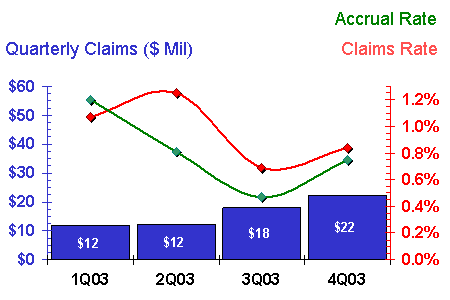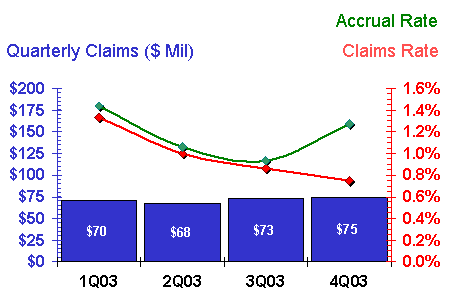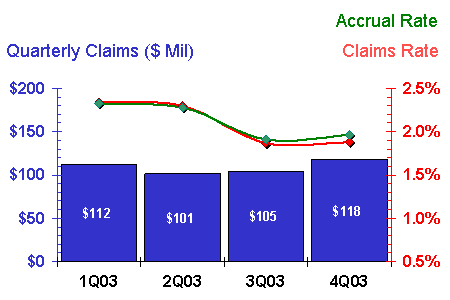April 20, 2004 |
ISSN 1550-9214 |
Telecom Warranties:While the ups and downs of the heavyweight manufacturers throws off the averages, it appears that TV and radio broadcast equipment generates half as much in warranty claims as newer technologies such as cellular and Internet gear. Are telecom warranty rates related to the maturity of the technology or the age of its manufacturers?In last week's column, we sliced and diced the automotive market into smaller, more meaningful units of warranty. This week, it's the telecommunications equipment category that needs some slicing. Just as a truck warranty isn't the same as a motorcycle's, neither is an Internet router the same as a TV transmitter tower. In information technology as in automotive, different products have different "natural" rates of warranty cost. Warranty claims and accrual rates for million-dollar semiconductor manufacturing machines may be in the tenths of a percent, but for something as commoditized as a PC printer, the "natural" rate of warranty expense might be above 10% of revenue. And that might be expected and sustainable, given the profitability of paper and ink supplies. Warranty Week has found that within the broad telecom equipment heading, the highest "natural" rates for warranty claims and accruals come with Internet and data communications gear, and the lowest come with TV and radio broadcasting equipment. Somewhere in between those two extremes are the claims rates for five other sub-categories of telecom equipment. Seven CategoriesFor simplicity, we've divided the universe of 150 telecommunications equipment manufacturers into seven rather broad and sometimes overlapping categories: plain old telephone, wireless, broadcasting, cable TV, satellite, data communications, and broadband. Rather than getting bogged down in definitions, here are the category headings and several examples of the manufacturers and the products they make: Plain Old Telephone In previous issues, we've examined warranty in several other closely allied areas of information technology manufacturing such as computers, disk drives, printers, semiconductors, and printed circuit boards. That analysis need not be repeated again now. Please see the March 30 column for that data. This time, we're including manufacturers of cellular and landline telephones here, but televisions and radios are lumped in with consumer electronics, which is not covered here. Fax broadcasting gear, fax servers, and voicemail systems are included here, but fax machines are not. They're lumped in with copiers in the office machine category. Modems, network cards, and Internet routers are included here, but the actual computers and terminals are not. As mentioned, it's easy to get bogged down with the definitions and boundaries of each category. It's better to rely on the examples above. Overall, the 350 companies under the broadest definition of information technology equipment manufacturers experience both claims and accrual rates that are consistently close to 2.4%. This we will call the "natural" rate of warranty activity for IT manufacturing. As detailed in past issues, computer manufacturers are generally above this average while data storage manufacturers are somewhat below it. Semiconductor and printed circuit board manufacturers are far below that average, as are most types of computer peripherals besides printers. All those manufacturers of computers, disk drives, peripherals, and semiconductors previously covered in the March 30 column are excluded here. What we're doing this week as a fifth and final look at the 2003 data is splitting up the broader "telecommunications equipment" category into seven smaller product groups. There are 150 warranty-reporting manufacturers under the telecom heading, and there are 20 to 40 manufacturers in each of the smaller groupings. In as many cases as possible, manufacturers were included in just one of the seven groups. This was also done with diversified PC/disk/peripheral manufacturers in the March 30 issue, and with truck/bus/car manufacturers in the April 13 column. To avoid artificially weighting or duplicating the data, the big companies are counted just once in one category -- the one that comprises their core business. At its core GM is a passenger car manufacturer, though it also makes train locomotives. At its core Lucent and Avaya are telephone equipment companies descended from Ma Bell herself. At their core, Hewlett-Packard and IBM are computer companies, though their complete product catalogs would be a thick book. Their spin-offs Agilent Technologies and Lexmark International make test equipment and printers, respectively. The Dangers of Rapid Weight LossIn the telecom sector, the only large companies for which multiple categories would have been necessary were Lucent and Nortel. Most others were firmly, or mostly, in just one of the seven categories. Lucent and Nortel, however, have extensive operations in both wireline and wireless telephony, as well as data, fiber optics, and broadband. For two reasons, we include them for this analysis in just one group: the traditional telephone category. First, Nortel's warranty accounting is under review and is likely to be restated in amended SEC filings. Second, Lucent's warranty claims and accruals positively plummeted during the fourth quarter -- so much that it skews the data in whatever category it's placed. With only 20 to 40 manufacturers in each category, the averages are highly susceptible to the weight of a few large manufacturers. And Lucent and Nortel are to telecom what GM and Ford are to passenger car manufacturers. During the first three quarters of 2003, Lucent's claims and accruals were in a range of $40 to $50 million per quarter. Claims were routinely around 3.5% of product sales, while accruals were closer to 2%. This had the effect of shrinking the reserve from $440 million on Sept. 30, 2002 to $330 million on Sept. 30, 2003. But then in the fourth calendar quarter of 2003 (Lucent's first fiscal quarter), claims fell to only $16 million while accruals fell to $19 million. It's wonderful news for Lucent, but it obscures the purpose of this column. As mentioned, of the seven telecom sectors, manufacturers of TV and radio broadcasting equipment have the lowest warranty claims and accrual rates of all. Perhaps this has something to do with the maturity of that market and the assembly lines that feed it. The makers of TV and radio transmitters, towers, editing and broadcasting equipment in 2003 saw claims and accrual rates very close to 1.0%, as is detailed in the chart below. Warranty Claims and Accrual Rates | |||||||||||||||||||||||||||||||||||||||||||
| Back to Part Four |

|
This Week’s Warranty Week Headlines | ||
|
General Motors fixes Saturn's continuously variable transmission problems, extends the transmission's warranty coverage from three years/36,000 miles to five years/75,000 miles. AutoWeek, April 20, 2004 | ||
|
Attensity Corp. announces list of supporters of its "Lean Quality" methodology, designed to boost product quality and reduce warranty expenses. Press Release, April 19, 2004 | ||
|
Consulting company launches Open Source Legal Defense Center, a set of legal defense services and connections to legal advice on Linux-related intellectual property issues. SearchEnterpriseLinux.com, April 19, 2004 | ||
|
Home warranties help mitigate repair costs, but maintenance insurance purchases are no cure-all for many homeowners. MSN Money, April 19, 2004 | ||
|
Australian supermarket chain, Aldi, sells low-cost notebook computers; product warranty, if any, is the responsibility of the supplier, not the retailer. Australian Reseller News, April 19, 2004 | ||
More Warranty Headlines below | ||

|

|
|
|

|
Warranty Headlines (cont’d) | ||
|
Analyst sees training of overseas warranty-support service people an issue for Dell Inc. Following customer complaints, Dell moved technical support for Optiplex and Latitude computers from India to U.S. call centers. InformationWeek, April 8, 2004 | ||
|
Hyundai unveils Competitor Comparison Guide in UK dealerships; computer system lets customers compare brands on price, performance, equipment, and warranty terms. Auto Industry (UK DTI), April 8, 2004 | ||
|
Curtis Ford Mercury dealer in New Bloomfield, Pennsylvania accused of accepting payment for extended warranty contracts he never initiated. Associated Press via WGAL TV, April 8, 2004 | ||
|
National Highway Traffic Safety Administration reveals 107 warranty claims and nine injuries related to overheating seat warmer in 2002 and 2003 Volkswagen Jetta. Salt Lake Tribune, April 7, 2004 | ||
More Warranty Headlines | ||

|
Warranty Headlines (cont’d) | ||
More Warranty Headlines | ||
Related Articles From Warranty Week |






